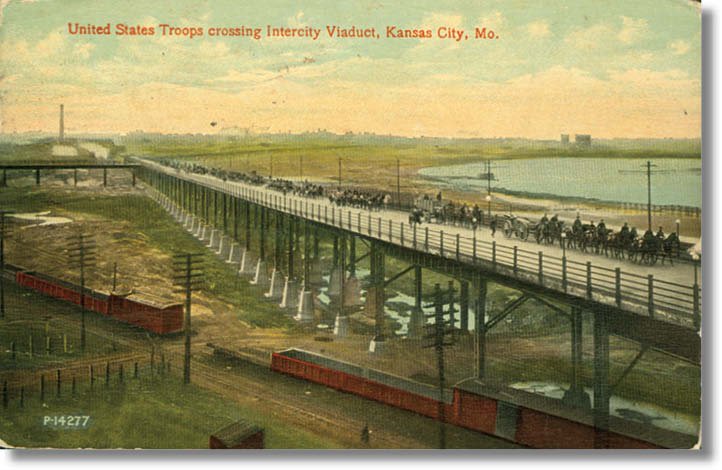By Michael Bushnell
Northeast News
June 8, 2016
This postcard, titled “United States Troops Crossing Intercity Viaduct, Kansas City, Mo.,” shows what seems to be an unending column of Army troops crossing the then-newly constructed bridge connecting Kansas City, Mo., and Kansas City, Kan. The land underneath the viaduct is depicted a number of ways in the older postcards, but most always there are varying degrees of standing water underneath the bridge, depending on the publisher of the postcard.
In this view, water is limited to a few standing pools. In other cards, depending on who hand-illustrated the card, the area is depicted as almost covered by water. What we now know as Lewis and Clark Viaduct was originally constructed as a privately owned and operated toll bridge for pedestrians, horses, mules, wagons and buggies. According to published articles in the Kansas City Journal-Post, it was a losing investment for its builders, as the local citizenry “disliked paying tolls.”
“Interstate” viaduct opened in January 1907 and was built at a cost of $3.25 million. It was 55 feet wide and had an 8-foot walkway for pedestrians.
On Oct. 30, 1918, the bridge was sold to the Kansas Cities (Missouri and Kansas) for about $1.7 million, about half its original cost. It was re-named Lewis and Clark Viaduct in 1969.
The long building pictured near the bottom of the card was the Kansas City Hay Press Company, organized in 1880 by Ephraim C. Sooy. At the time of the card’s printing, Kansas City was home to the largest hay market in the world, processing over 3,000 railroad cars of hay annually. The card itself was sent to Dean Dupont of Steelville, Mo., on Oct. 26, 1914. It reads, “Dear Brother, Thought I’d drop you a card as I was sending them. Am in K.C. but leave for Slater in 30 minutes. Am feeling fine. Love to all. Loving brother, Ted.”



















